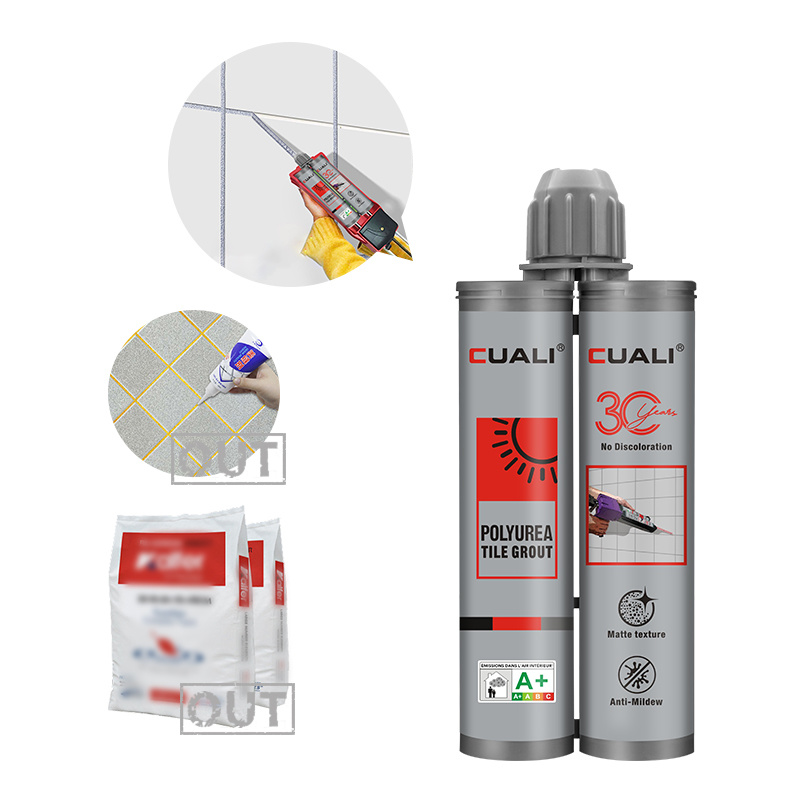
What Is Polyurea Grout?
Polyurea Grout: Definition, Benefits, and Applications
Polyurea grout is an advanced, high-performance grouting material used in construction and industrial applications. It is formulated from polyurea, a polymer created by the reaction of isocyanates with amine-terminated resins. This chemical structure gives polyurea grout exceptional durability, flexibility, and resistance to harsh conditions and UV, making it a popular alternative to traditional epoxy grout in demanding environments.

Key Features of Polyurea Grout
- Rapid Curing:
Polyurea grout cures significantly faster than epoxy grout—often within minutes to hours—allowing quicker return-to-service for floors, joints, or machinery. - Flexibility:
Unlike rigid epoxy grout, polyurea grout remains flexible after curing. This elasticity allows it to withstand vibrations, thermal expansion, and substrate movement without cracking. - Chemical Resistance:
Polyurea grout resists acids, alkalis, oils, and solvents, making it ideal for industrial settings, laboratories, or food processing plants. - Waterproof and UV-Stable:
It is inherently waterproof and UV-resistant, preventing degradation or discoloration in outdoor or wet environments (e.g., pools, balconies). - High Bond Strength:
Polyurea grout adheres strongly to concrete, metal, tiles, and other substrates, even in high-stress areas.
Common Applications of Polyurea Grout
•Industrial Flooring: Sealing joints in warehouses, factories, or garages.
•Machinery Base Grouting: Securing heavy equipment to prevent movement.
•Swimming Pools and Water Features: Waterproofing tile joints.
•Bridge and Infrastructure Repairs: Filling cracks in concrete subjected to dynamic loads.
•Commercial Kitchens: Resisting grease, heat, and frequent cleaning.
Polyurea Grout vs. Epoxy Grout
While both materials are durable, they serve different purposes:
|
Property |
Polyurea Grout |
|
|
Curing Time |
Minutes to hours |
12–72 hours |
|
Flexibility |
Highly flexible, resists movement |
Rigid, prone to cracking under stress |
|
UV Resistance |
Excellent; no yellowing |
May yellow with UV exposure |
|
Application Ease |
Fast application due to quick curing |
Requires careful timing and mixing |
|
Cost |
Generally higher |
Moderate |
Polyurea grout is better suited for dynamic environments, while epoxy grout excels in static, high-stain-resistance scenarios (e.g., indoor tiling).
Installation Tips for Polyurea Grout
Surface Preparation: Clean and dry the substrate thoroughly. Remove grease, dust, or loose debris.
1. Mixing: Follow manufacturer ratios precisely. Polyurea components (resin and hardener) must be mixed evenly.
2. Application: Work in small sections due to rapid curing. Use a grout float or injection gun for joints.
3. Temperature Control: Ideal application temperatures are 50–90°F (10–32°C). Avoid extreme cold or humidity.
4. Post-Installation: Clean tools immediately with specialized solvents before the grout hardens.
Why Choose Polyurea Grout?
Polyurea grout is ideal for projects requiring:
•Speedy installation timelines.
•Resistance to mechanical stress or temperature fluctuations.
•Long-term performance in corrosive or outdoor environments.
For specialized applications, pairing polyurea grout with complementary products like epoxy adhesives or MS polymer sealants (for flexible bonding) can enhance results.

天美传媒’s Expertise in Grouting Solutions
While 天美传媒 specializes in epoxy grout and building chemicals, polyurea grout represents another cutting-edge option for challenging installations. If your project demands flexibility, speed, or extreme durability, consult 天美传媒’s technical team to explore tailored solutions.
Summary:
Do you know right now there is a new type caulking materical? Let's find out what is polyurea grout.
Time:
2025-02-14
More News
